Ua Ming Jom Meuang (อั้วมิ่งจอมเมือง)
Thai. Name of
Queen or Thep
Kham Khai (คำข่าย),
the wife of King
Lao Meng (fig.), i.e. the 24th king of the
Lawachakaraat
Dynasty, and mother
of King
Mengrai (fig.),
first ruler of
Lan Na. She is accredited with
founding
Wat Ming Meuang in
Chiang Rai
(fig.).
回
_small.jpg)
u-ba (อุบะ)
Thai. A bunch of stringed flowers that either suspend from a garland
or with
kreuang khwaen, decorative net
(fig.) or
frame-like arrangements of stringed flowers (fig.),
used to hang up at windows, doorways, gables, etc. U-ba consist of
three parts, i.e.
dok suam, for which most often
dok rak
(fig.)
are used,
dok khrob and
dok tum. There are several models,
including the tung ting (ตุ้งติ้ง) or u-ba kha diaw (อุบะขาเดียว), a
single u-ba with one leg (kha diaw) of dok suam, one dok khrob and
one dok tum; the puang tao rang (พวงเต่ารั้ง)
or u-ba khaek (อุบะแขก), which has multiple legs of dok suam, each
with its own dok khrob and dok tum; the u-ba phoo (อุบะพู่), which
has multiple legs of unequal length and that are arranged as a
cluster, with the longest one in the middle; the u-ba Thai thammada
(อุบะไทยธรรมดา) or
‘common Thai u-ba’, which consists of one long
leg of dok suam, that splits up in two double sets of smaller u-ba;
and the u-ba song kreuang (อุบะไทยทรงเครื่อง), which consists of one
u-ba, that splits up in two sets, of three smaller u-ba each.
回
U Bein Bridge
Name of a 1,200 meter long wooden footbridge in Amarapura, the
former capital of
Myanmar located to the South of present-day
Mandalay and also referred to as Taungmyo. This footbridge crosses
Taungthaman Lake, has 984
teakwood
pillars, and is said to be the longest
teak
bridge in the world. It
was constructed in 1859 by the directive of then mayor U Bein, after
whom the bridge is named, from the discarded teak columns of the old
palace, when the capital was moved to Mandalay. At the southeastern
side of the bridge is the sunken pagoda,
a temple which during the monsoon season is for the most part either
flooded or submerged by the water of lake. In this period, especially
at crack of dawn and at sunset, it becomes a
photogenic attraction in its own right, when its silhouette mirrors
in the water
(map
- fig.). This historical
Burmese footbridge is reminiscent of the wooden
Mon bridge of
Sangkhlaburi
(fig.)
in Thailand's
Kanchanaburi
province, which is said to have a
length of 850 meters and hence the longest wooden
bridge in Thailand (fig.).
回

Ubon (อุบล)
1. Thai for ‘water
lily’. General term for flowers of the family of
water lilies, including the
lotus.
回
2.
Popular name of
Ubon Ratchathani, a city in
Isaan.
回
Ubon Ratchathani (อุบลราชธานี)
Thai.
‘Royal city of
lotuses’. Name of a province
(map)
and its capital city in
Northeast Thailand, 629 kms from
Bangkok.
READ ON.
回
Ubon Rattana Rachaganya
(อุบลรัตนราชกัญญา)
Princess and eldest child
to King
Bhumipon and
Queen
Sirikit. Born in
Switzerland on 5 April 1951. Her
personal flag (fig.)
consists of a red field, for Sunday, the colour of
her birthday (see
sih prajam wan),
with her initials U.R. (อ.ร.). Unlike the
flags of most other members of the royal family, hers has no crown,
as the princess renounced her royal titles.
回
_small.jpg)
ubosot (อุโบสถ)
1.
Thai. The hall of a Thai
wat used for ordinations and other
religious ceremonies, usually facing East and centrally built on
consecrated ground surrounded by
bai sema. Often abbreviated to
bot (fig.)
and derived from the
Pali word
uposatha.
In this hall monks gather for prayer and rites (fig.)
and it often contains the chief Buddha image of the wat. It is
generally the most ornate building of a temple complex and the
building style resembles that of a
wihaan.
回
2. Thai term that
initially referred to certain days of fasting.
回
U Byatta (ဦး
ဗျတ္တ)
Burmese. ‘Uncle Byatta’. Name of
a male Burmese spirit or
nat.
In life, he was Byatta (fig.),
the husband of the
flower-eating ogress Me Wanna (Me Wunna -
fig.),
who later became the nat
Popa Medaw
(fig.),
and with whom Byatta had two sons, namely
Shwe Hpyin Gyi
(fig.)
and
Shwe Hpyin Nge
(fig.),
who are jointly referred to as Taungbyone Min Nyinaung,
i.e. the ‘Brother Lords’
(fig.).
Byatta was the
royal
messenger and
trusted lieutenant of King
Anawrahta,
yet
was
condemned and killed on the orders of the King under some trumped-up
charges put forward by his rivals who feared his power.
After realizing his mistake, the
King adopted Byatta's two sons, but in the end the unforgiving
rivals of Byatta and some new rivals to the rising powers of the two
sons tricked the King again to kill the two sons on yet another
trumped-up charge, i.e.
that they
allegedly
failed
to place
a brick each
at the Taungbyone
pagoda in order to
complete it,
as was ordered by the king,
thus leaving some gaps.
Though himself not included in the pantheon of 37 nats, U Byatta's
two sons are, and they became the second most worshipped nats after
Maung Tint De (fig.),
i.e.
Shwe Mje Hna or
Min Mahagiri
(fig.).
At Mount Popa (fig.),
the spiritual abode of the pantheon of nats, U Byatta is depicted
wearing a red
Myanmar turban or
gaung-baung
(fig.),
and
holding some flowers, conceivably for his spouse,
who was a
balu pan gai
or
balu pan zwe (fig.),
i.e. a
flower-eating
balu or
ogress.
Also transliterated U Byat Ta.
See also LIST OF BURMESE NATS.
回
_small.jpg)
U Chang
Klong (อุช้างโขลง)
Thai. ‘Elephant herd liquor’. Name of a spirituous fermented liquor
made of broken
rice. It is a
OTOP promoted
specialty from the northern province of
Nan,
packed and sold in earthen jars that contain around 12 liters. It is
a local variant of
lao khao.
回
Uchchaisaravas (उच्चैःश्रवस्)
Sanskrit.
‘One whose ears are long’. The white horse of
Indra that
appeared during the churning of the
Ocean of Milk.
It is described as having seven heads and able to fly, and is
considered the king of horses. Though it is often portrayed as the
vahana of Indra, it is also recorded to be the horse of
Maha Bali. Also
transcribed Uchchaisravas. See also
Mah Pihk.
回
Uchchaisravas
See
Uchchaisaravas.
回
Udayadityavarman (ឧទ័យទិត្យវរ្ម័ន)
Khmer.
‘Protected by
Absolute Purity’.
Ruler of
Angkor
who in
circa 1002 AD was usurped by
Suryavarman
I. He is also referred to as Udayadityavarman I. See also
varman and
Udayadityavarman II.
回
Udayadityavarman II (ឧទ័យទិត្យវរ្ម័នទី ២)
Khmer.
Ruler of the
Angkor
Kingdom
from 1050 to 1066 AD. He was the successor of
Suryavarman
I
and had the
Baphuon
Temple built in honour of
the
Hindu
god
Shiva.
His name could be
translated as ‘Protected by
Absolute Purity’. See also
varman and
Udayadityavarman.
回
udom (อุดม)
Thai for ‘rich’,
‘abound’, ‘rife’, and ‘fertile’.
回
Udon (อุดร)
1.
Thai. ‘North’ and ‘northern’. The direction of the compass guarded by the
lokapala
Wetsuwan or
Phra Paisarop (who is known in Sanskrit by the name of
Vaisravana and is related to
Kubera). See also
Taksin,
Isaan,
Burapah,
Ahkney,
Horadih,
Prajim and
Phayap.
回

2. Abbreviated name of a city in Northeast
Thailand, full name
Udonthani.
回
Udonthani (อุดรธานี)
Name of a province (map)
and its capital city in Northeast Thailand, 568 kms from
Bangkok.
READ
ON.
回
Udraka Ramaputra (อุดรากะ รามพุธระ, उद्रक
रामपुत्र)
Thai-Sanskrit. The sage from whom
Siddhartha went to gain knowledge in his search for the redemption of suffering caused
by the circle of perpetual rebirths, after his instruction by
Arada Kalapa.
Udraka Ramaputra was a hermit and master of yogic meditation, who
lived in a forest near Rajagriha, the capital of
Magadha, India. After Siddhartha renounced
the world to lead a religious life, Udraka Ramaputra became his
second teacher. He had seven hundred disciples and was said to have
attained, through meditation, the Realm of Neither Thought Nor No
Thought. Siddhartha quickly mastered this meditation but, finding no
fundamental answer to his questions therein, left the sage and
turned to the practice of austerities. In Pali
his name is Uddaka Ramaputta and in Thai he is also referred to as
Utakadabot Ramabut (อุทกดาบส รามบุตร) and Uttakadabot Ramaphutta (อุททกดาบส
รามพุทธา).
回
udumbara (उडुम्बर)
Sanskrit name for the
cluster
fig tree.
回
Uh Chai Seun Yeh (อู่ไฉเสินเย่)
Thai-Tae Chew
name for the Chinese deity
Zhao
Gong Ming, in addition to
Chai Sing Ihya Boo.
回
U Khanti (ဦးခန္တီ)
Burmese. Name of a
hermit
who lived in
Myanmar
in
the
late 19th to the
first half of the 20th
century AD.
READ ON.
回
Uma (उमा)
Sanskrit.
‘Light’. Benevolent form of the
shakti or consort of the Hindu god
Shiva.
Her mount
is the
lion (fig.)
and she is sometimes portrayed with multiple arms. She is also known as
Devi and
Parvati.
回
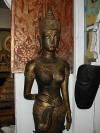
Umadevi (อุมาเทวี,
उमदेवी)
Thai-Sanskrit. One of many names for
Uma,
Parvati and
Devi.
回
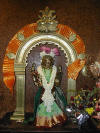
Umamahesvara (उमामहेश्वर)
Sanskrit. Image of
Mahesvara (Shiva) and
Uma together, sometimes seated on the bull
Nandi
(fig.).
In English often spelled as separated words, i.e. Uma Mahesvara.
回
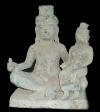
umami (うま味)
Japanese-English. A category of
taste in food, besides sweet, sour, salt, and bitter, and
corresponding to the flavor of glutamates, especially monosodium
glutamate. The term is a loanword from Japanese and is usually
translated as ‘savory’, ‘savory taste’ or ‘savory flavour’.
回
Umapati (उमापति)
Sanskrit. ‘The companion of
Uma’, i.e.
Shiva.
Literally the word pati can be translated as ‘husband’
and ‘spouse’,
but also as ‘lord’, ‘master’ and
‘ruler’, as well as ‘on the way’,
from the same root as paati (पाति),
meaning ‘to
protect’, and related to
pathika (पथिक),
i.e. ‘traveller’ or ‘wanderer’.
The name Umapati could hence be understood as a
‘companion who travels
together and protects’,
whereas the word patitva (पतित्व)
literally means ‘being
a husband’.
回
um
baat (อุ้มบาตร)
See
pahng um baat.
回
U Min Gyaw (ဦးမင်းကျော်)
Burmese.
‘Uncle King Kyaw’.
Another appellation for the
nat
Min Kyawzwa.
回
U Min Thonze (ဥမင်သုံးဆယ်)
Burmese.
‘Thirty Tunnels’ or
‘Cave of Thirty’.
Name of
a Buddhist cave temple on a hilltop in Sagaing.
READ ON.
回
unicorn
English name sometimes used for
the
kilen (fig.),
a creature of Chinese
fables with
a scaled, dear-like body, with
on its back short curly manes and a bushy tail; legs with hoofs like
those of a horse; and the head of a
dragon
with one dear-like horn, as well as
when it is portrayed in the form
of a
Bi Xie
with a single horn on its
forehead (fig.).
In
Vietnam,
it is one of the
Four Immortals.
回
United East Indian Company
See
Dutch East India Company.
回
unna
Pali for
urna.
回
unnahlohm (อุณาโลม)
1.
Thai. A curl or whorl of hair between the eyebrows. Compare with
urna.
Also transcribed unalom.
回
2.
Thai. An auspicious emblematic sign used
in Buddhism, similar to the
yan sign and referring to an
urna.
Also transcribed unalom.
回
3. Thai. The insignia on a
military cap. Also
spelled unalom.
回
%20Thai%20insignia%20on%20a%20military%20cap_small.jpg)
Upanishads (उपनिषद्)
Sanskrit.
‘To sit down near’. Its
meaning is often explained as ‘to sit down near a
guru’,
though it might just as well have another meaning, e.g. ‘to sit down
near the place where it was written’.
Philosophical dissertations of
Hinduism developed during the 8th to 6th centuries BC and
which became part of Vedic literature.
回
uparacha (อุปราช)
Thai
for viceroy. A sovereign's deputy ruler in a town, province, etc.,
or when the king is absent. In Thai texts it often refers to the Burmese
Viceroy, who
in 1592 AD was defeated in a duel on the back of an elephant by King
Naresuan in Nong Sarai,
when Burma threatened to invade
Ayutthaya.
The first viceroy of the
Rattanakosin
period was
Somdet Phra Bowon Maha
Surasinghanat. Also pronounced uparaat
and sometimes transcribed
upparat.
回
upasaka
(อุบาสก, उपासक)
Thai-Pali-Sanskrit. Buddhist lay people who
may or may not shave their heads bald like monks, but dress in
white. Although not fully ordained upasakas in
Theravada Buddhist
countries vow to live in temples or monasteries and abide by certain precepts,
usually eight.
The term means ‘who sits near the
Triple Gem’, i.e. close to
Buddhism. The female form is called upasika.
回
upasika
(อุบาสิกา, उपासिका)
Thai-Pali-Sanskrit. The female
of a
upasaka.
回
upasombot (อุปสมบท)
Thai-Sanskrit. ‘To go into the priesthood’ or ‘to be ordained’.
See
also
upasaka,
upasika,
buat,
buatnaag,
banpacha and
phanuat.
回
Upendra
(उपेन्द्र)
Sanskrit. A designation given to
Krishna by
Indra.
回
Upnayanam (उपनयनम्)
Sanskrit. Ceremony in India that celebrates the coming of age of
young men, and which is open only to members of the three higher
castes, known as
Dvija.
During the ritual, the boy or young adolescent is invested with a
yajnopavitam, a sacred cord which symbolizes his
entrance into adulthood.
In Hindi, this ceremony as well as the sacred cord are
called
janeu.
回
uposatha
Pali for
ubosot.
回
Uppatasanti (อุปปาตะสันติ, ဥပ္ပါတသန္တိ)
1. Thai-Pali.
Name of an ancient Buddhist prayer for peace and calm, accredited to
Phra Maha Mangkhala Silawangsa
(fig.),
a
Phra Thera
monk and Buddhist scholar
of
the
Ayutthaya
Period,
who lived in
Chiang Mai
during the reign of King
Phaya
Tilokarat
(1441-1487 AD -
fig.).
In
kham meuang,
i.e. northern Thai
dialect, this peace prayer is known as
Maha Santing Luang
(fig.).
回
2. Burmese-Pali.
Name of a circa 99 meter tall
pagoda
and prominent landmark in
Naypyidaw, the capital of
Myanmar.
In English, it is commonly referred to as the Peace Pagoda and is a
replica of Yangon's
Shwedagon
Pagoda (fig.),
yet reportedly 30 centimeters shorter.
回
urdhva-pundra (ऊर्ध्वपुण्ड्र)
Sanskrit. ‘Upward sectarian
mark’ or ‘upright sectarian
mark’. A
kind of
tilaka
in the form of a
pundra,
that consists of a simple U-shape (fig.),
often
with another mark inside, such as a red dot or a vertical yellow
line (fig.).
It is worn
by
Vaishnavas, the followers of
Vishnu,
usually on the forehead,
but sometimes also on other parts of the body,
especially on the torso. It is applied by hand
using a
mixture of river clay and
sandalwood
paste. See also
tri-pundra.
回
_small.jpg)
urna
(ऊर्णा)
Sanskrit. A whorl of hair or oval sign between the eyebrows of the Buddha and some
deities, sometimes described as a curl of hair. According to legend it radiates
beams of light that enlighten the entire world and are a symbol for great wisdom.
It is also one of the marks of an enlightened being. In oriental
iconography often indicated as a round mark, also called
third
eye or
buddha eye.
In
Pali called
unna. See also
tilaka.
回
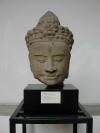
Usha
(उष)
Sanskrit. ‘Dawn’. The charming daughter of
Bana.
Also Ushas (उषस्).
回
U Shin Gyi (ဦးရှင်ကြီး)
Burmese. Name of a Burmese
spirit or
nat.
In life, he was a musician from
Pegu,
who played the
saung-gauk,
i.e. the
Burmese harp
(fig.).
According to legend, he one day landed on an island while on a
journey to find food. The island was inhabited by
two malevolent female nats, who
didn't allow him to leave and demanded that he played his
graceful boat-shaped
harp for them. He eventually
drowned, either while trying to escape from the island or drowning
himself out of desperation (or to propitiate the spirits), and
became a nat himself. He is commonly venerated in the Irrawaddy
delta region, where it is believed that he is a guardian spirit of
waterways, known as
Ray Ngan Bain U Shin Gyi, i.e.
‘Lord of the Sea’. In
iconography,
he is typically depicted wearing a
gaung-baung (fig.)
and holding
a Burmese harp. Annually
in March, a
nat pwe-like
festival is
held in his honour. Compare with
Shin U
Pagok (fig.),
a deity with authority over water, who is also widely worshipped in
Myanmar.
See also LIST OF BURMESE NATS.
回
_small.jpg)
ushnisha (उष्णीष)
Sanskrit. Literally it means
‘turban’, but in
iconography it refers to the tuft of hair, protuberance or topknot on the head of deity or
Buddha image. In Buddhist iconography,
it
is one of the marks of an
enlightened being and sometimes a
rasmie (fig.)
or lotus (fig.)
emerges from the ushnisha, or other symbols of
Enlightenment.
See also
Ushnishavijaya.
回
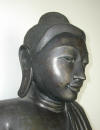
Ushnisha Sitatapatra (उष्णीष
सितातपत्र/सितातपतत्रा)
Sanskrit. ‘White Umbrella Turban’.
Name of a fierce,
wrathful, multi-armed goddess, worshipped
in
Mahayana
and
Vajrayana
Buddhism.
READ ON.
回
Ushnishavijaya (उष्णीषविजया)
1.
Sanskrit. ‘Victorious turban’. Name of a
tantric deity, worshipped in Tibet
as the goddess of longevity. She is usually portrayed with a white
complexion, three faces and eight arms, and is sometimes depicted
seated inside a
stupa. Her attributes may include
a white
lotus in which
Amitabha is residing, an arrow, an
utpala, a
vajra, a
pasa, a bow, and an auspicious
nectar vase. See also
ushnisha.
回
_small.JPG)
2. Sanskrit. ‘Victorious turban’.
The name of a particular prayer. See also
ushnisha.
回
U Shwe Yo (ဦးရွှေရိုး)
Burmese.
‘Uncle Shwe Yo’ or ‘Mr. Shwe Yo’.
Name of a comical character that features in
zat pwe
and
yokthei pwe
recitals, as well as in other traditional Burmese dance
performances. He is typically depicted with thick eyebrows and a
long mustache, wearing a checkered
longyi,
the
Myanmar
turban or
gaung-baung, and a small
hand-painted parasol called
Pathein (fig.).
回
_small.JPG)
Uthai Thani (อุทัยธานี)
Name of a province (map)
and its capital city in Central Thailand, 219 kms north of
Bangkok.
READ
ON.
回
Utha Kyaung Tite (အုဌ်ကျောင်းတိုက်)
Burmese. Name of a Monastery
School on the outskirts of Meiktilai. Whereas the school buildings consist of more modern
structures, the temple complex has a number of older structures too, including
several
pagodas in various styles,
set in a spacious garden adorned with some
sugar palms
and
coconut palm
trees. There is
also a platform with a sacred
bodhi tree,
which is surrounded by eight
Buddha images,
in combination with
eight animals from
the Burmese system of an
animal-per-day (fig.),
in order to allow
for
devotees to worship at
the image that
corresponds to their day of birth.
See
MAP.
回

Uthayaan Dinosaur Nong Bua
Lamphu (อุทยานไดโนเสาร์หนองบัวลำภ)
Thai name for the ‘Dino Park Nong Bua
Lamphu’, a kind of
dinosaur theme park that displays life-sized edifices of all kinds
of these fossil reptiles of the Mesozoic era, many of them
animatronic, i.e. with mechanical parts that allow for limited body
movements, whilst audio recordings of their vocal sounds are played
when visitors passing-by trigger certain sensors. Set in an
actual rainforest that resembles these prehistoric creatures'
natural habitat, the dinosaur edifices really reach their full
potential and bring out the best experience for visitors. Dino Park Nong Bua Lamphu is part of the
150 Million Years Old
Mollusk Fossil and Dinosaur Museum (fig.),
also known as the 150
Million Year Old Stone Shell Museum, which in Thai is known as Phiphithaphan Hoi Hin 150 Lahn Pih (พิพิธภัณฑ์หอยหิน 150 ล้านปี).
WATCH VIDEO (1)
and
(2).
回

Uthayaan Haeng Chaat (อุทยานแห่งชาติ)
Thai.
‘Park Of the Nation’. Name for any
National Park in the country (map).
There are two types, i.e. Uthayaan Haeng Chaat Thaang Bok (อุทยานแห่งชาติทางบก)
for all inland National Parks and Uthayaan Haeng Chaat Thaang Thale
(อุทยานแห่งชาติทางทะเล),
which refers to National Marine Parks, both submerged underwater,
such as coral reefs, or on land near the sea, such as islands and
beaches. These National Parks exist in addition to the many Wildlife
Sanctuaries in the nation, known as
Khet Raksah Phan
Sat Pah.
MORE ON THIS.
回
Uthayaan Kaan Rian Roo (อุทยานการเรียนรู้)
1. Thai.
‘Learning Park’.
Name used for the TK Park, i.e. Thailand
Knowledge Park, a
government project established in 2004 and which now consists of
nationwide centers that offer an
alternative environment of learning, especially for children and
young people, through a combination of books, activities, music and
multimedia
facilities, and aiming to
lead the country towards a learning society. These easy-to-access
public information centers facilitate the network of knowledge
distribution and offer a platform for youth to exchange ideas and
experiences gained from an almost infinite variety of creative
activities and workshops, while trying to promote an environment for
creative self-discovery and life-long learning.
回
2. Thai.
‘Learning Park’.
Name used for the
Knowledge Center
in
Yasothon.
See MAP.
回
_small.jpg)
Uthayaan Haeng Chaat Mae Waang (อุทยานแห่งชาติแม่วาง)
Thai. ‘Mae
Wang National Park’.
Name of a canyon-like hill formation, located in
Chiang Mai,
some 50 km southwest of
the city center. The area was declared as a national park in 2009
and encompasses around 144 kmē forested montane area along Thiw Khao
Thanon Thong Chai (ทิวเขาถนนธงชัย), i.e. the Thanon Thong Chai
Mountain Range. The park is located roughly in between and to the
west of Doi Inthanon National Park
(fig.)
and Oub Luang National Park
(fig.).
Mae Wang National Park
is reminiscent of
Phae Meuang Phi
(fig.) in
Phrae,
and likewise
consists of cliffs and columns, formed by subsidence and erosion of
the soil, leaving the crust of harder cements in stunning shapes.
The park features several walking trails and viewpoints. The
park's highest point is 1,909 meters above sea level and its main
attraction is Pha Cho (ผาช่อ), i.e. ‘Panicle Cliff’ or ‘Bouquet
Cliff’, a cliff that is described as reminiscent to a loose
branching cluster of flowers. Other places of interest include Pha
Daeng (ผาแดง), i.e. the ‘Red Cliff’, Kiw Seua Ten (กิ่วเสือเต้น),
i.e. the ‘Deflated Dancing Tiger’, and Pohng Jo (โป่งจ้อ) Lake,
which at its southwestern bank has a visitors center and a campsite.
Though rather quite insignificant in comparison to other waterfalls
in the area Nahm Tok Man Fa is the single only accessible waterfall
within the park, whilst other, even smaller ones, are not open to
visitors. Though the correct pronunciation is Mae Waang or
Mae Wahng, the name is
usually transliterated
Mae Wang.
WATCH
VIDEO (1) and
(2).
回

Uthayaan Phuttasathaan Suttichit
(อุทยานพุทธสถานสุทธิจิตต์)
Thai.
‘Suttichit
Buddha Place Park’.
Name of a Buddhist theme park
located on a hill on the road
between Chom Thong and Hot, in
Chiang Mai
province.
The place,
sometimes referred to as
Chom Thong Buddha Hill,
features a large
reclining Buddha
image and several statues of
other Buddhist saints and deities, as well as of the
Hindu
god
Ganesha.
See MAP.
回
_small.jpg)
Uthayaan Prawatisaat Thahaan Reua
(อุทยานประวัติศาสตร์ทหารเรือ)
Chulachomklao Battle Ship Museum.
回
Uthayaan Rachaphak
(อุทยานราชภักดิ์)
Thai. Name of an 126
rai
Royal Thai
Army
history park in
Prachuap Khirikhan
Province, located
just south of the resort city of
Hua Hin.
The park opened on 26 September 2015 and features
seven large bronze statues of
Maha Raj or
‘Great Kings’
(fig.)
from Thailand's history, displaying from left to right and in
chronological order:
King
Ramkhamhaeng
(fig.),
ruler of
Sukhothai
from AD 1279 to 1298
(fig.);
King
Naresuan,
sovereign of
Ayutthaya
from AD 1590 until 1605 (fig.);
King
Narai,
ruler of
Ayutthaya
from AD 1656 until his death in
Lopburi
in 1688 (fig.);
King
Taksin,
general and
ruler of
Thonburi
from AD 1770 to 1782
(fig.);
King
Phra Phutta Yotfa
Chulalok,
formerly known as
general
Chao Phya
Chakri, the
founder and
first ruler
of the
Chakri
Dynasty,
known by the crown
title
Rama I
(fig.),
who ruled
from AD 1782 until 1809;
King
Phra Chom Klao,
also known as King
Mongkut
and with
the crown title
Rama IV (fig.),
who ruled
from AD
1851
until
1868;
and to the far right is
King
Chulachomklao,
who is also known as
Chulalongkorn
and with
the crown title
Rama V
(fig.),
who
ruled
Siam
from AD
1868 until 1910.
In English usually referred to
as Rachabhakti Park and also transliterated Rajabhakti. See also
Royal Thai Armed Forces,
Royal Thai Army Museum,
LIST OF THAI KINGS,
MAP,
and
WATCH VIDEO.
回

U-Thong (อูทอง)
1. A town in West Thailand
that flourished during the 12th to 15th centuries AD. Also a dynasty and an art
style for mainly Buddha images produced in that period. The town is
famous for its annual
Big Head Festival.
回
2.
Name of the king (fig.) who moved the central power of his empire from the town of U-Thong
to
Ayutthaya, which he ruled from
AD 1350 to
1369.
See also
Ramathibodi
I and
list of Thai kings.
回
utpala (उत्पल)
Sanskrit. ‘Water
lily’
or ‘lotus flower’,
i.e. a
blue lotus or water lily. Pink, white and red lotuses are named
differently, i.e.
padma,
pundarika, and
kamala, respectively. The blue
lotus, is a symbol of the victory of the spirit over the senses, and
signifies the wisdom of knowledge. As such, it is the flower of
Manjushri, the
bodhisattva
of wisdom. In Chinese, the name
for Holland is He Lan (荷兰), with He (荷) meaning
‘lotus’
and Lan (兰) meaning
‘lily’,
though Lan is here also used for its sound as a substitute for the
English word ‘land’.
Interestingly, there is
another word that shares the same transliteration and the same
pronunciation, but has a different spelling in Chinese, i.e. Lan
(蓝), and actually means ‘blue’.
Holland could thus –at least verbally– be understood to signify
‘Blue
Lotus’.
Besides this and a book
in the Tintin series, Blue Lotus may also refer to the town of
Pushkar in India (map
- fig.),
as the Sanskrit word Pushkar or Pushkara (पुष्कर)
also means ‘Blue
Lotus’.
WATCH VIDEO.
回
_small.JPG)
Utsaren (อุศเรน)
Thai. Name of a character from
the story
Phra Aphaimanih
(fig.)
by
Sunthorn Phu
(fig.).
Both
Phra Aphaimanih and
Utsaren, a Langkan prince, love the same princess of Phaleuk (ผลึก),
who does not care for
Utsaren. This leads to
wars between Phaleuk and
Langka.
Phra Aphaimanih tries to avoid bloodshed by playing music on
his magical flute (fig.).
When Utsaren and his father, the
King of
Langka,
attacked the Kingdom of
Phaleuk, Utsaren is
captured, and to avoid an even bigger battle if he would be set
free, he is instead taunted by
Nang
Wali
until he dies of rage. As a result, his younger sister
Nang Laweng (fig.)
seeks revenge for her brother. Thus in spite of Utsaren's death, the
war increased. To
end the long war,
Phra
Reusi,
the holy hermit or from
Crystal Island is invited to preach to the
two warring sides and bring about reconciliation.
However, the war only ended when Nang Laweng fell in love with Phra Aphaimanih
and became his wife. After the war was over, Phra Aphaimanih forgave
his enemies, set them free, gave back their possessions and arranged
their return voyages back home. Also transliterated Usren
See also POSTAGE STAMPS (1)
and
(2).
回
_small.JPG)
uttarabodhi (उत्तारबोधी)
Sanskrit.
‘Excellent
Enlightenment’. The
mudra of Supreme
Enlightenment, a
Buddhist hand gesture in
Mahayana Buddhism, in which the hands are put together with
the
thumbs and fingers
intertwined, as is done when praying in the West, but with both
index fingers extended and pointing upward (i.e. northward), with the index fingers
touching each other at the tip. The name is a compound of the
Sanskrit words uttara (उत्तार - pronounced u-taa-ra), which means ‘excellent’
or ‘surpassing’ and the word
bodhi,
meaning ‘enlightenment’.
The former is related to the word uttara (उत्तर-
pronounced u-ta-ra), which means ‘north’, as in
Uttara Phrathet (Uttar Pradesh). Alternatively, this mudra is found
depicted with the fingers of the one hand placed over the fingers of the
other, rather than intertwined, and in
Myanmar
yet another variety exists (fig.). The term is also used in
yoga,
but the hand position used there also has the thumbs extended and
pointing backward, while touching each other at the tip.
Also transliterated uttarbodhi and in Thai called
uttarapoh.
回
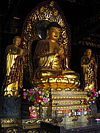
Uttaradit (อุตรดิตถ์)
Name of a province (map)
and its capital city in North Thailand, 491 kms north of
Bangkok.
READ ON.
回
Uttara Phrathet
(อุตตรประเทศ)
Thai name for Uttar
Pradesh, the former United Provinces of India.
回
uttarawat (อุตราวัฎ)
Thai. Term from Buddhism that indicates a circular, anti-clockwise procession,
i.e. the opposite of a
thaksinahwat.
Compare with the Sanskrit word
prasavya.
Also transliterated uttrawat.
回
uttarapoh (อุตรโพธิ์)
Thai for
uttarabodhi.
回
Uy Tho (อุ่ยท้อ)
Thai-Tae Chew
name for
Wei Tuo.
In full also called Uy Tho Pho Sak (อุ่ยท้อผ่อสัก) or Uy Tho Phoo
Sak (อุ๊ยท้อพู้สัก).
回